Is A Telecaster Good For Rock? This question has been asked by many guitar enthusiasts, and the answer is a resounding yes. The Fender Telecaster, with its distinctive shape and sound, has been a staple in rock music since its inception.
In this article, we’ll explore the Telecaster’s suitability for rock, its sound characteristics, and how different models fit various rock genres.
The Telecaster has been embraced by rock legends and garage band heroes alike. But is it the right axe for your rock endeavors? Let’s dive into the world of Telecasters and find out.
You can use the table of contents below to take you to the area that interests you. Click on the little box to open it and then click on the section of the article you want to read, or you can read from start to finish if you want the full Telecaster rock experience!
The Short Answer
The Telecaster is a versatile guitar suitable for various rock genres, from Classic to Punk. Its bright, cutting tone has been embraced by iconic players, and different models cater to specific rock styles. Through customization, such as pickup selection, the Telecaster’s sound can be tailored to individual preferences. This adaptability, combined with its timeless appeal, solidifies the Telecaster’s status as a go-to guitar for rock enthusiasts.
Keep On Reading (Below) To Learn More
The Telecaster’s Sound Profile

Characteristics Of The Telecaster’s Sound
The Telecaster is known for its bright and cutting tones, often described as “twangy.” Its dual-pickup configuration allows for a wide range of sounds, making it suitable for various rock sub-genres, from Classic Rock to Punk.
The Telecaster doesn’t just walk the rock walk; it talks the rock talk. Its performance in rock music is like a perfectly executed stage dive – thrilling, memorable, and always landing on its feet.
Telecaster Models Suitable For Rock
Rock musicians have a variety of Telecaster models to choose from, each offering unique features and characteristics. Here’s a quick look at some of the suitable Telecaster models for rock.
However, I can tell you from experience that you can use any Telecaster to get great rock sound!
American Professional Telecaster
- Features: Modern “Deep C” neck shape, V-Mod single-coil pickups, treble bleed circuit
– - Price Range: $1,400 – $1,600
– - Best for: Professional musicians seeking a versatile sound with modern playability
American Vintage ’52 Telecaster
- Features: Vintage-style pickups, ’52 U-shaped neck, brass bridge saddles
– - Price Range: $2,000 – $2,300
– - Best for: Players seeking a classic Telecaster sound and vintage feel
Classic Vibe ’50s Telecaster
- Features: Vintage-tint gloss neck, Alnico III pickups, 21 narrow-tall frets
– - Price Range: $400 – $500
– - Best for: Budget-conscious players wanting a retro sound with modern playability
American Ultra Telecaster
- Features: Ultra Noiseless™ Vintage Tele® pickups, Modern D neck shape, compound-radius fingerboard
– - Price Range: $1,900 – $2,100
– - Best for: Players seeking high-end features with noiseless pickups for studio and live performance
Player Telecaster
- Features: Alnico V pickups, 22-fret, 9.5-inch-radius fingerboard, six-saddle string-through-body bridge
– - Price Range: $700 – $800
– - Best for: Intermediate players looking for quality craftsmanship at an affordable price
Comparison Of Telecaster Models
Here is a table that summarizes the main features of these guitars. They all rock out, although I’m partial to the Player series Tele!
| Model | Features | Price Range | Best For |
|---|---|---|---|
| American Professional Telecaster | Modern “Deep C” neck, V-Mod pickups | $1,400 – $1,600 | Versatile sound, modern playability |
| American Vintage ’52 Telecaster | Vintage-style pickups, ’52 U-shaped neck | $2,000 – $2,300 | Classic Telecaster sound, vintage feel |
| Classic Vibe ’50s Telecaster | Vintage-tint gloss neck, Alnico III pickups | $400 – $500 | Retro sound, budget-friendly |
| American Ultra Telecaster | Ultra Noiseless™ pickups, Modern D neck | $1,900 – $2,100 | High-end features, noiseless pickups |
| Player Telecaster | Alnico V pickups, 22-fret fingerboard | $700 – $800 | Quality craftsmanship, affordable price |
How To Choose The Right Telecaster

Choosing the right Telecaster for rock involves careful consideration of your playing style, genre, preferences, budget, and the guitar’s aesthetics.
Consider Your Playing Style
Your playing style is a vital factor in choosing the right Telecaster. Here’s how to match your style with the right model.
- Rhythm Players: If you primarily play rhythm guitar, consider models with a warm and full sound, such as the American Vintage ’52 Telecaster.
– - Lead Players: For lead guitarists, models with bright and cutting tones, like the American Professional Telecaster, may be more suitable.
– - Versatile Players: If you play both rhythm and lead, consider versatile models like the American Ultra Telecaster.
Evaluate Your Genre Preferences
Different Telecaster models suit various rock sub-genres. So, consider your preferred rock style.
- Classic Rock: Vintage-inspired models like the American Vintage ’52 Telecaster are ideal for classic rock tones.
– - Punk Rock: Consider models with sharp tones like the Player Telecaster for aggressive punk sounds.
– - Indie Rock: Indie rock players may prefer versatile models like the Classic Vibe ’50s Telecaster.
Budget Considerations
Your budget plays a significant role in your choice.
- Entry-Level: The Classic Vibe ’50s Telecaster offers great value for beginners or budget-conscious players.
– - Mid-Range: Intermediate players may consider the Player Telecaster for quality at a reasonable price.
– - High-End: Professional players seeking premium features might opt for the American Ultra Telecaster.
Assess The Guitar’s Feel And Playability
Trying out different models in person can help you find the perfect fit.
- Neck Shape: Different models have varying neck shapes. For example, the Modern “Deep C” neck of the American Professional Telecaster may suit some players, while others may prefer the ’52 U-shaped neck of the American Vintage ’52 Telecaster.
– - Weight and Body Contour: Assess the weight and body shape to ensure comfortable playing. Models like the American Ultra Telecaster offer ergonomic designs.
Consider The Guitar’s Aesthetics
Choose a model that resonates with your visual preferences.
- Finish and Color: Telecasters come in various finishes and colors. Whether you prefer a vintage sunburst or a sleek black, there’s a Telecaster to match your aesthetic.
– - Hardware and Details: Consider the hardware and details, such as the type of bridge and tuners. These not only affect the look but also the functionality of the guitar.
Research And Read Reviews
- Expert Opinions: Read professional reviews and watch video demonstrations to understand the specific characteristics of each model.
– - User Reviews: User reviews can provide real-world insights into the guitar’s performance and reliability.
Making Your Telecaster Sound Better
Making a Telecaster sound better for rock is an art that involves understanding the instrument and experimenting with various settings, effects, and techniques.
Amplifier Settings
The right amplifier settings can bring out the best in your Telecaster.
- Gain: Adjusting the gain control can add grit and distortion, which is essential for rock tones. Experiment to find the right balance between clarity and aggression.
– - EQ Settings: Tailor the bass, mid, and treble controls to shape your sound. Boosting the mids can help your Telecaster cut through the mix in a band setting.
– - Volume: Don’t be afraid to turn up the volume. Telecasters often sound better when the amp is working harder.
Effects Pedals
Effects pedals can add texture and character to your Telecaster’s sound.
- Overdrive/Distortion: An overdrive or distortion pedal can add warmth and sustain, enhancing your rock tone.
– - Reverb and Delay: These effects can add depth and space to your sound, especially for lead playing.
– - Wah and Modulation: For more experimental rock sounds, consider wah-wah, chorus, phaser, or flanger pedals.
Pickup Selection And Tone Control
Your Telecaster’s pickups and onboard controls offer various tonal options:
- Bridge Pickup: For bright and cutting tones, use the bridge pickup. It’s great for aggressive rhythm playing and piercing solos.
– - Neck Pickup: Switch to the neck pickup for a warmer and fuller sound. It’s suitable for bluesy leads and mellower rhythm parts.
– - Both Pickups Together: The pickup combination will give you a well-balanced, mildly out-of-phase sound that’s great for certain chord voices and lead tones.
– - Tone Control: Don’t overlook the tone knob. Rolling it back can soften the Telecaster’s brightness while opening it up can add sparkle.
String Choice
The type of strings you use can significantly impact your sound.
- Gauge: Heavier gauge strings (e.g., .010-.052) can add thickness and sustain, while lighter gauges (e.g., .009-.042) offer easier playability and a brighter tone.
– - Material: Nickel-plated steel strings are a popular choice for rock, offering a balanced tone with good brightness. Pure nickel-wrapped strings give a mellower, more vintage tone.
Guitar Setup And Maintenance
A well-set-up Telecaster will not only play better but sound better.
- Action: Adjusting the string height (action) can affect playability and tone. Lower action offers easier playability, while higher action can add resonance and sustain.
– - Intonation: Proper intonation ensures that your Telecaster stays in tune across the fretboard, which is essential for clean and accurate rock playing.
– - Regular Maintenance: Regular cleaning, string changes, and check-ups with a professional guitar technician can keep your Telecaster sounding its best.
Playing Techniques
Your playing approach can also shape the Telecaster’s sound.
- Picking Dynamics: Experiment with different picking strengths and positions. Picking near the bridge can add brightness while picking near the neck offers a softer tone.
– - Fretting Techniques: Utilize techniques like bending, vibrato, and slides to add expression and character to your rock playing.
Comparing Pickups For Rock Performance
This table can help you choose the right pickups to achieve the desired sound for your music.
It’s easier to get a rock tone out of the pickups that come pre-installed in your guitar than for some types of Metal sub-genres that require specialized pickups to nail a particular sound, often in a drop tuning.
| Pickup Model | Tone Characteristics | Suitable Rock Genres | Price Range |
|---|---|---|---|
| Fender Custom Shop ’51 Nocaster | Warm, vintage tone | Classic Rock, Blues Rock | $$$ |
| Seymour Duncan Hot Rails | High output, aggressive | Hard Rock, Metal | $$ |
| DiMarzio Twang King | Bright, twangy | Country Rock, Indie Rock | $$ |
| Fender Vintage Noiseless | Smooth, noise-free | Alternative, Progressive Rock | $$$ |
| Lace Sensor Gold | Balanced, clear | Versatile across genres | $$$ |
Telecaster Vs. Other Iconic Rock Guitars
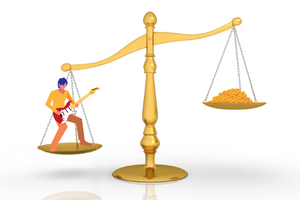
Rock music has seen the rise of several iconic guitars, each with its unique sound and style. Here’s how the Telecaster compares to the Stratocaster, Les Paul, and Gibson SG. While it shares some similarities with these guitars, its bright and twangy sound sets it apart.
Please remember opinions vary, so this is just a general guide! When it comes right down to it, none of these guitars is clearly better than the others for Rock.
Telecaster Vs. Stratocaster

- Sound: The Telecaster is known for its bright and twangy sound, while the Stratocaster offers a more versatile tone with its three-pickup configuration. The Strat’s sound is often described as “glassy” and “bell-like.”
– - Playability: Both guitars have a comfortable playing feel, but the Stratocaster’s contoured body might offer a more ergonomic experience for some players.
– - Usage: The Telecaster is favored for rhythm playing in Rock, Country, and Blues, while the Stratocaster is renowned for its lead guitar capabilities, especially in Blues and Rock.
Telecaster Vs. Les Paul
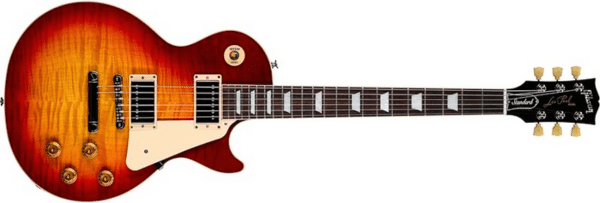
- Sound: The Telecaster’s bright and cutting tones contrast with the Les Paul’s warm and rich sound. The Les Paul’s humbucking pickups offer a fuller and more resonant tone.
– - Playability: The Telecaster’s lighter weight and slimmer neck might be more comfortable for some players, while the Les Paul’s thicker neck provides a different feel.
– - Usage: The Telecaster is versatile across rock genres, while the Les Paul is often associated with hard rock and heavy metal.
Telecaster Vs. Gibson SG

- Sound: The Telecaster’s signature twang contrasts with the Gibson SG’s aggressive and thick sound. The SG’s dual humbuckers provide a meatier tone.
– - Playability: The SG’s lightweight and thin body offers easy playability, while the Telecaster’s solid construction provides a different playing experience.
– - Usage: The Telecaster is used across various rock styles, while the SG is often associated with Hard Rock and Classic Metal.
My Pick As The Best Guitar For Rock
So, which one of these iconic rock machines is best? Well, it depends on things like the sub-genre or rock you play, the sound you’re looking for, and the rig you’re using. They’re all winners, so use the one you like best!
I’ve owned many Teles, Strats, Les Pauls, and SGs over the years, and they all have a special place in my heart for Rock!
If I had to choose just one guitar, my preference for Classic Rock would be the Gibson SG. Have a listen to players like Tony Iommi (Black Sabbath), Angus Young ( AC/DC), and Frank Zappa, to name a few, and you’ll hear the incredible tonal variety this guitar is capable of!
What I love most about the SG is that it’s lightning-fast to play and has incredible upper-fret access! It’s just that simple. It also has that “diabolical Devil” look that Angus talks about with its double-horned configuration. Lol ?
Rock Guitar Price Comparisons
It’s challenging to directly compare the price of one guitar to the other since each guitar type has so many models to choose from.
However, if you’re looking for something more budget-friendly, check out the Fender line of Teles and Strats. The Fender Squier line (not included in the table below) is even more affordable, and they sound and play great for the money!
| Guitar Type | Sound Characteristics | Price Range | Suitability for Rock |
|---|---|---|---|
| Telecaster (Various Models) | Bright, twangy, versatile | $400 – $2,300 | Suitable for various rock styles |
| Stratocaster | Glassy, bell-like, versatile | $700 – $2,500 | Suitable for blues and rock lead playing |
| Les Paul | Warm, rich, resonant | $600 – $4,000 | Suitable for hard rock and heavy metal |
| Gibson SG | Aggressive, thick, meaty | $1,200 – $2,500 | Suitable for hard rock and classic metal |
The Telecaster In Different Rock Genres

The Telecaster’s adaptability and unique sound characteristics make it suitable for a wide array of rock genres. From the raw energy of punk rock to the expressive nuances of blues rock, the Telecaster offers something for every rock musician.
Classic Rock
The Telecaster’s bright and clear sound has made it a favorite among Classic Rock musicians.
- Sound Characteristics: Offers a vintage tone that can be both smooth and aggressive.
– - Notable Players: Keith Richards, Bruce Springsteen, David Gilmour.
– - Recommended Models: American Vintage ’52 Telecaster for that authentic ’50s vibe.
Punk Rock
In Punk Rock, the Telecaster’s sharp and aggressive sound fits perfectly.
- Sound Characteristics: Capable of raw and cutting tones that suit the energetic nature of punk.
– - Notable Players: Joe Strummer of The Clash.
– - Recommended Models: Player Telecaster for affordability without sacrificing quality.
Indie Rock
Indie Rock artists often seek unique and nuanced tones, and the Telecaster’s versatility makes it a popular choice.
- Sound Characteristics: From jangly and bright to warm and mellow, suitable for various indie styles.
– - Notable Players: Jonny Greenwood of Radiohead.
– - Recommended Models: Classic Vibe ’50s Telecaster for a blend of vintage and modern tones.
Hard Rock
For Hard Rock players, the Telecaster can deliver powerful and driving tones.
- Sound Characteristics: Can achieve thick and heavy sounds, especially when paired with the right pedals and amps.
– - Notable Players: John 5 of Rob Zombie (also a Metal player).
– - Recommended Models: American Professional Telecaster for modern playability and sound.
Blues Rock
The Telecaster’s expressive quality makes it suitable for Blues Rock.
- Sound Characteristics: Offers both biting leads and soulful rhythm tones.
– - Notable Players: Roy Buchanan.
– - Recommended Models: American Vintage ’52 Telecaster for a true bluesy feel.
Alternative Rock
In Alternative Rock, the Telecaster’s wide tonal range allows for creative experimentation.
- Sound Characteristics: Adaptable to various alternative rock sub-genres, from Grunge to Post-Rock.
– - Notable Players: Graham Coxon of Blur.
– - Recommended Models: American Ultra Telecaster for high-end features and versatility.
Country Rock
Though primarily associated with country music, the Telecaster’s “twang” has found a home in Country Rock as well.
- Sound Characteristics: Bright and twangy tones perfect for country-infused rock.
– - Notable Players: Brad Paisley.
– - Recommended Models: Classic Vibe ’50s Telecaster for an authentic country rock sound.
Progressive Rock
Progressive Rock players seeking a wide palette of tones can find a partner in the Telecaster.
- Sound Characteristics: Capable of intricate and textured sounds to suit complex arrangements.
– - Notable Players: Alex Lifeson of Rush (early years).
– - Recommended Models: American Ultra Telecaster for cutting-edge features and tonal flexibility.
Famous Rock Players Using Telecasters
These iconic players, each with their unique musical biography, have shaped the sound of rock music and demonstrated the Telecaster’s ability to adapt to various rock styles and playing techniques.
Jeff Beck (Yardbirds & Solo Act)

Jeff Beck’s relationship with the Fender Telecaster began during his time with The Yardbirds. His use of the Telecaster extended into his solo career, exploring various musical genres from Rock and Blues to Jazz Fusion. One of his most famous Telecasters is an Esquire model, used on the track “Beck’s Bolero.”
In 1973, Jeff Beck traded his Yardbirds Esquire guitar for the “Tele-Gib” guitar made by Seymour Duncan. It was created by combining a ’59 Telecaster body, a ’63/’64 neck, and humbuckers from a Flying V to blend the Telecaster’s sharp attack with the warmth of a Les Paul.
Jimmy Page (Yardbirds & Led Zeppelin)
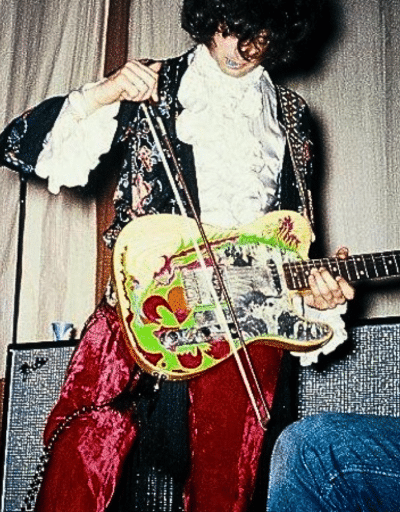
Led Zeppelin’s mastermind, Jimmy Page, has a storied history with the Telecaster, most notably his famous “Dragon” Telecaster. This iconic guitar started its life as a 1959 Fender Telecaster in blonde finish, given to Page by Jeff Beck when they both were members of The Yardbirds.
Page played this Telecaster during his time with The Yardbirds and on Led Zeppelin’s debut album, where it was responsible for some of the most recognizable riffs in rock history. He didn’t use the 59′ Les Paul he bought from Joe Walsh until he recorded Led Zeppelin II. The rest is history!
Eric Clapton (Yardbirds & Blind Faith)
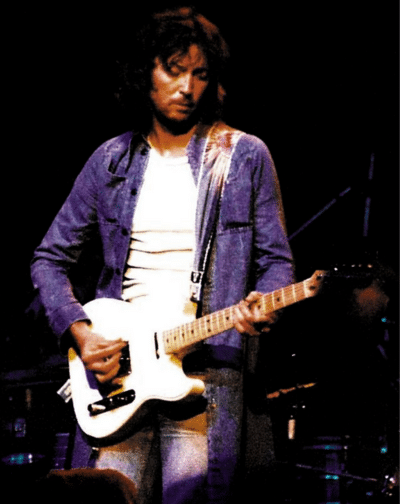
Eric Clapton has a rich history with various guitars, including the Telecaster. One of the most notable periods when Clapton played a Telecaster was during his time with the Yardbirds, a British rock band he joined in 1963.
Clapton also famously played a Telecaster with a Custom Tele body and a Strat neck at Blind Faith’s Hyde Park concert in 1969.
David Gilmour (Pink Floyd)

Although David is known for playing his iconic “Black Strat,” he has utilized Telecasters in both studio recordings and live performances, contributing to his legendary rock sound. Known for his expressive and emotive playing, Gilmour has used the Telecaster to craft solos and textures that are integral to Pink Floyd’s sonic landscape.
Keith Richards (The Rolling Stones)

Keith Richards, the longtime guitarist of The Rolling Stones, has been a driving force in rock music since the early ’60s. Known for his innovative open tunings and rhythm playing, Richards has crafted some of rock’s most memorable riffs. His 1953 Fender Telecaster “Micawber” and various custom Telecasters have been central to hits like “Brown Sugar” and “Start Me Up.”
Bruce Springsteen (E Street Band)

Bruce Springsteen, also known as “The Boss,” has been a defining figure in American rock music. With his E Street Band, Springsteen’s anthemic rock sound has resonated with audiences for decades. His 1952 Fender Telecaster has been his main guitar for many years, contributing to classics like “Born to Run” and “Thunder Road.”
Joe Strummer (The Clash)

Joe Strummer, the co-founder and rhythm guitarist of The Clash, played a vital role in the punk rock movement. His aggressive rhythm playing on his 1966 Fender Telecaster helped define hits like “London Calling” and “Should I Stay or Should I Go,” making him a symbol of punk’s raw energy.
Jonny Greenwood (Radiohead)

Jonny Greenwood, the lead guitarist of Radiohead, is known for his experimental approach to guitar playing. Utilizing a Fender Telecaster Plus, Greenwood’s innovative techniques have contributed to groundbreaking songs like “Creep” and “Paranoid Android,” helping to redefine alternative rock.
Beware Of “Tele Addiction!”

Ah, the Telecaster addiction – a common and delightful affliction that has swept through the rock music community like a catchy riff at a sold-out concert. It starts innocently enough; a strum here, a riff there, and before you know it, you’re hooked on that bright, twangy tone that only a Tele can deliver!
Rock legends and garage band heroes alike find themselves drawn to the Telecaster’s siren call. It’s like a favorite old pair of jeans – it just fits, no matter the style of rock you’re playing. From the vintage aficionado seeking that classic ’50s vibe to the modern rocker craving a cutting edge, the Telecaster has a way of finding a permanent spot in guitar collections.
Some say it’s the simplicity of the design, others claim it’s the versatility of the sound, but all agree: once you’ve fallen for a Telecaster, there’s no turning back. It’s a love affair that transcends generations and genres, a six-stringed romance that’s become a rock ‘n’ roll tradition.
So, if you find yourself unable to pass a music store without peeking in to see if there’s a Telecaster in the window, don’t worry – you’re in good company. Welcome to the club of Telecaster enthusiasts, where the only cure for this addiction is more rock ‘n’ roll! ?
Key Takeaways

Here are the three most important key takeaways from the Telecaster’s role in rock music.
- The Telecaster has proven its adaptability across various rock genres, from Classic and Punk Rock to Blues and Progressive rock. Its unique sound characteristics make it suitable for a wide array of playing styles and musical expressions.
– - Different Telecaster models cater to different needs and budgets. From vintage-inspired models to modern variations, players can choose the Telecaster that resonates with their playing style, genre preferences, and aesthetic tastes.
– - The Telecaster’s sound can be further enhanced and tailored for rock through specific amplifier settings, effects pedals, string choices, playing techniques, and modifications. These elements allow players to craft their unique Telecaster tone for rock music.
Are You Qualified To Make Guitar Adjustments Or Modifications?
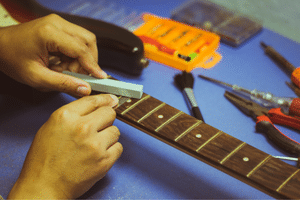
It’s great to work on your guitars, especially if you have a lot of them, but you should always be aware of your limitations.
Adjusting things like an electric guitar’s string height (action) or pickup height can be straightforward. Still, some adjustments require the proper training and experience, like adjusting a guitar’s truss rod.
When you doubt your ability to adjust, repair, or modify your guitar, it’s always best to bring it to a competent guitar technician or luthier (guitar designer & builder). You can permanently damage your guitar, and it might never play and sound right again!
Making modifications to your guitar can void its manufacturer’s warranty and cause permanent damage to the instrument. Certain modifications are irreversible, so you may be stuck with them, even if you desperately want to restore the guitar to its original condition!
I learned that the hard way over the years until I did a three-year apprenticeship in a guitar repair shop. Now I have my own home workshop with the proper training and equipment to safely maintain and repair all my instruments.
Remember: “When In Doubt, Send It Out!”
Frequently Asked Questions

Here are some of the questions I get asked about the Telecaster.
If your question does not appear here, please put it in the comments, and I will get right back to you with an answer.
Is The Telecaster Suitable For Beginners?
Absolutely! The Telecaster’s simple design and comfortable playability make it a great choice for beginners. Various affordable models cater to those just starting their guitar journey.
What Amplifiers Pair Well With A Telecaster For Rock?
Amplifiers from brands like Fender, Marshall, and Vox are popular choices for rock tones with a Telecaster. The right amp depends on the specific sound you’re seeking.
Can I Use A Telecaster For Recording In A Studio?
Absolutely! The Telecaster’s versatile tone makes it an excellent choice for studio recording in rock and other genres.
Can A Telecaster Be Used For Other Genres Besides Rock?
Yes, the Telecaster is versatile and can be used in genres like Country, Jazz, Blues, and even Metal. Its distinct tone and playability make it adaptable to virtually any musical style.
How Do I Get A Punk Rock Sound With A Telecaster?
You may want to use the bridge pickup and dial in a raw, aggressive tone with your amplifier and pedals for a punk rock sound. A Telecaster’s sharp attack can be perfect for punk rhythms.
What Are Some Techniques To Make The Telecaster Sound Better For Alternative Rock?
For alternative rock, experimenting with different pickup combinations, tone settings, and effects like reverb or delay can create unique and nuanced tones. The Telecaster’s versatility allows for creative sound shaping.
How Does The Telecaster’s Body Shape Affect Its Rock Sound?
The Telecaster’s solid body shape contributes to its bright and resonant tone. Its simple, single-cutaway design allows easy access to higher frets, facilitating lead playing in rock.
Final Thoughts

The question “Is A Telecaster Good For Rock?” opens up a world of exploration into the Telecaster’s multifaceted relationship with rock music. From its bright, cutting tone to its suitability for various rock genres, the Telecaster has proven to be a versatile and beloved instrument for rock musicians.
Famous rock players like Keith Richards, Bruce Springsteen, and Joe Strummer have wielded Telecasters to create iconic rock sounds. Different models, such as the American Vintage ’52 Telecaster, cater to specific rock styles, and the guitar’s customizable nature allows for further tonal exploration.
Pickup selection plays a vital role in shaping the Telecaster’s rock sound. Options like Seymour Duncan Hot Rails offer aggressive tones for hard rock, while Fender Vintage Noiseless provides a smoother sound for alternative rock.
Techniques and gear, including string gauge choice and amplifier pairing, can further enhance the Telecaster’s performance in rock. Whether it’s achieving a punk rock edge or a classic rock warmth, the Telecaster’s versatility shines through.
The Telecaster has a rich and diverse legacy in rock music. Its adaptability to various rock styles and ability to be tailored to individual preferences make it a timeless and cherished instrument. Its popularity and versatility make it a top choice for rock musicians everywhere.

Here’s a great video from Robert Baker comparing rock tones using a Les Paul, a Strat, and a Tele. They all sound great, but Robert says he prefers the sound of the Tele’s bite when it comes to rock sounds.
Check it out, and you be the judge! Let me know which guitar you prefer in the comments section below.
What To Read Next ➡ Is A Telecaster Good For Metal? – Myth Or Reality?
Related Article ➡ What Genre Is A Telecaster Good For? (It’s Not Just Country)
Tell Me What You Think

Please leave a comment below if you enjoyed this article, have any questions about Telecasters, or want to give your point of view. I will be happy to help you.
- What’s your favorite Telecaster for playing Rock?
- What’s your favorite modification to a Tele to make it a Rock N’ Roll machine?
- If you could only buy one rock guitar, which one would you buy and why?
- What else is on your mind?



Hello!
I’ve recently developed an interest in playing the guitar, and I’m particularly drawn to the idea of playing rock music. I came across your article about whether a Telecaster is suitable for rock, and it seems like you’ve covered a lot of ground. However, as a beginner, I have a few questions to help me better understand this topic:
1. In the article, you mention that the Fender Telecaster is a versatile guitar suitable for various rock genres. Could you elaborate a bit more on what makes the Telecaster versatile in terms of its sound? How does it manage to cater to different rock styles?
2. The article talks about the sound profile of the Telecaster, describing it as bright and cutting, often referred to as “twangy.” As someone who’s still learning about different guitar tones, could you explain what “twangy” means in terms of guitar sound and how it contributes to the overall rock experience?
3. I noticed you’ve provided a list of Telecaster models suitable for rock, each with its own features and price range. As a beginner, how should I approach choosing a model that’s right for me? Are there any specific features I should prioritize, or should I focus on a particular price range?
Thank you for taking the time to answer my questions. I’m really excited to learn more about playing the guitar and exploring the world of rock music!
Hi, Skamalka
Thank You for your comments and questions!
The Telecaster is one of the most versatile guitars available. It is easily adaptable to any style of Rock. Its “twangyness” mainly comes from the design of the angled single-coil pickup in the bridge position. The bridge plate itself also contributes to this sound.
It’s easy to vary the tone of a Tele by rolling back the volume and tone controls, especially if you want less twang. Some Telecasters come loaded with humbucking pickups for more of a balanced sound.
As a beginner, I recommend you start with a Fender “Squier” Tele, which gives great value for the money. Any pickup configuration will work fine for Rock.
Best of Luck! 😎
Frank 🎸
played a strat for years…always kinda snubbed the tele…but after all you’ve said here i may need to reconsider. especially since im “electric-less”!
Hi Jahkaz
Thank You for your comments!
Yeah, as a beginning player, I used a Strat for years. When I finally got a Tele, it didn’t take long to realize all I had been missing!
I recommend you play several Teles during your search for your next electric guitar.
Rock On!
Frank
Hey Frank! 🎸 I really enjoyed your article on whether a Telecaster is good for rock. You provided an in-depth exploration of the Telecaster’s sound characteristics and how different models can cater to various rock genres. It’s clear that the Telecaster’s versatility is one of its standout features.
Here’s my question: In your experience, have you found that certain pickups or modifications are particularly effective in enhancing the Telecaster’s performance for specific rock styles? I’d love to hear more about how players can fine-tune their Telecaster to suit their preferred rock genre. Keep on rockin’! 🤘😄
Hi Hanna
Thank you for your comment and question!
Yes, you can change the pickups on a Telecaster to modify its sound and signal output. Since the majority of Telecasters come with single-coil pickups, you can buy a variety of pickups that fit directly into the pickup cavities. Some of them have a double coil design to eliminate noise and create a stronger amplifier signal.
Rock On!
Frank